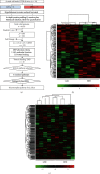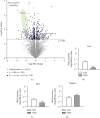Proteome Analysis of the Hypothalamic Arcuate Nucleus in Chronic High-Fat Diet-Induced Obesity
- PMID: 34840970
- PMCID: PMC8617565
- DOI: 10.1155/2021/3501770
Proteome Analysis of the Hypothalamic Arcuate Nucleus in Chronic High-Fat Diet-Induced Obesity
Abstract
The hypothalamus plays a central role in the integrated regulation of feeding and energy homeostasis. The hypothalamic arcuate nucleus (ARC) contains a population of neurons that express orexigenic and anorexigenic factors and is thought to control feeding behavior via several neuronal circuits. In this study, a comparative proteomic analysis of low-fat control diet- (LFD-) and high-fat diet- (HFD-) induced hypothalamic ARC was performed to identify differentially expressed proteins (DEPs) related to changes in body weight. In the ARC in the hypothalamus, 6621 proteins (FDR < 0.01) were detected, and 178 proteins were categorized as DEPs (89 upregulated and 89 downregulated in the HFD group). Among the Gene Ontology molecular function terms associated with the DEPs, protein binding was the most significant. Fibroblast growth factor receptor substrate 2 (Frs2) and SHC adaptor protein 3 (Shc3) were related to protein binding and involved in the neurotrophin signaling pathway according to Kyoto Encyclopedia of Genes and Genomes analysis. Furthermore, high-precision quantitative proteomic analysis revealed that the protein profile of the ARC in mice with HFD-induced obesity differed from that in LFD mice, thereby offering insight into the molecular basis of feeding regulation and suggesting Frs2 and Shc3 as novel treatment targets for central anorexigenic signal induction.
Copyright © 2021 Chang Yeon Kim et al.
Conflict of interest statement
The authors declare no conflicts of interest regarding the publication of this paper.
Figures





Similar articles
-
Comparative Hypothalamic Proteomic Analysis Between Diet-Induced Obesity and Diet-Resistant Rats.Int J Mol Sci. 2025 Mar 5;26(5):2296. doi: 10.3390/ijms26052296. Int J Mol Sci. 2025. PMID: 40076916 Free PMC article.
-
Endospanin1 affects oppositely body weight regulation and glucose homeostasis by differentially regulating central leptin signaling.Mol Metab. 2016 Nov 3;6(1):159-172. doi: 10.1016/j.molmet.2016.10.009. eCollection 2017 Jan. Mol Metab. 2016. PMID: 28123946 Free PMC article.
-
Single-Nucleus RNA Sequencing of the Hypothalamic Arcuate Nucleus of C57BL/6J Mice After Prolonged Diet-Induced Obesity.Hypertension. 2020 Aug;76(2):589-597. doi: 10.1161/HYPERTENSIONAHA.120.15137. Epub 2020 Jun 8. Hypertension. 2020. PMID: 32507042 Free PMC article.
-
Mechanistic insight into high-fat diet-induced metabolic inflammation in the arcuate nucleus of the hypothalamus.Biomed Pharmacother. 2021 Oct;142:112012. doi: 10.1016/j.biopha.2021.112012. Epub 2021 Aug 10. Biomed Pharmacother. 2021. PMID: 34388531 Review.
-
Microglia in physiological conditions and the importance of understanding their homeostatic functions in the arcuate nucleus.Front Immunol. 2024 Sep 4;15:1392077. doi: 10.3389/fimmu.2024.1392077. eCollection 2024. Front Immunol. 2024. PMID: 39295865 Free PMC article. Review.
Cited by
-
Molecular Imprints of Clinical Comorbidities in Hypothalamic Extracellular Vesicles at the Onset of Obesity.ACS Omega. 2025 May 29;10(22):23563-23581. doi: 10.1021/acsomega.5c02274. eCollection 2025 Jun 10. ACS Omega. 2025. PMID: 40521556 Free PMC article.
-
FTO gene expression in diet-induced obesity is downregulated by Solanum fruit supplementation.Open Life Sci. 2022 Jun 15;17(1):641-658. doi: 10.1515/biol-2022-0067. eCollection 2022. Open Life Sci. 2022. PMID: 35800074 Free PMC article.
-
Single-cell and spatial omics: exploring hypothalamic heterogeneity.Neural Regen Res. 2025 Jun 1;20(6):1525-1540. doi: 10.4103/NRR.NRR-D-24-00231. Epub 2024 Jul 10. Neural Regen Res. 2025. PMID: 38993130 Free PMC article.
References
Publication types
MeSH terms
Substances
LinkOut - more resources
Full Text Sources
Medical
Miscellaneous

